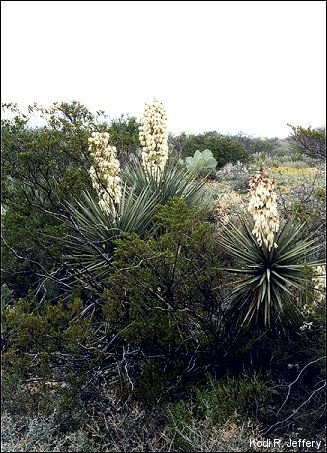

Allelopathy—what a mouthful! But this stands for something of great importance to many plants in the Chihuahuan Desert. Unlike the mobile animals, plants cannot defend their hold on the land by tooth and claw, but must rely on other strategies. As desert inhabitants are well aware, static protective devices that stab, tear, or rip are widespread for protection against animals. Yet another line of defense against herbivores is the production of poisons in the leaves and stems of many desert herbs and shrubs. But what about protection from other plants?
The desert has only limited resources—especially the vital water and
usable nitrogen required by plants. Thus there is constant competition for the assets
necessary for successful growth and reproduction. Toxins that need to be eaten and
thorns are useless against other plants, but chemical warfare is nothing if not
versatile. By poisoning the area around itself, a plant, such as Creosotebush, can
stand off invasion by others, and it is this capacity that is called by that strange
word, allelopathy.

Listen to the Audio (mp3 format) as recorded by KTEP, Public Radio for the Southwest.
Contributor: Arthur H. Harris, Laboratory for Environmental Biology, University of Texas at El Paso.
Desert Diary is a joint production of the Centennial Museum and KTEP National Public Radio at the University of Texas at El Paso.

The shrubs intermingled with the blooming yuccas are creosotebush, which is believed to secrete chemicals from its roots that prevent the roots of other creosotebushes from invading its root zone. A prickly pear cactus is visible in the background. Photograph by Kodi R. Jeffery, Big Bend, March 2001.
Mahall, B.E., and R.M. Callaway. 1992. Root communication mechanisms and the intracommunity distributions of two mojave desert shrubs. Ecology 73:2145-2151.